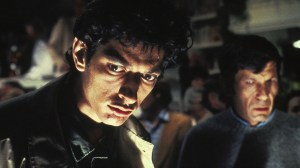Celebrating his 73rd birthday today is Tobe Hooper, the horror icon who gave birth to one of the genre’s most menacing monsters with Leatherface. Despite how well known the film and its subsequent sequels are, there are lots of misconceptions about the original Texas Chain Saw Massacre and mythical stories that resulted from the filming of the grimy horror masterpiece.
Videos by ComicBook.com
The Texas Chainsaw Massacre franchise went a few different directions that didn’t entirely connect with audiences, but the effectiveness of the original can’t be denied. The grimy, 16mm shot independent film gave audiences something they’d never quite seen before in 1974, a departure from films created by auteurs like Alfred Hitchcock and Roman Polanski.
Check out some surprising information about Tobe Hooper’s genre-changing film and let us know why you love the film in the comments!
MORE NEWS: Directors Selected For Texas Chainsaw Massacre Prequel Announced / New Leatherface Poster Revealed / Guy Pearce Gets Brutal In New Trailer For Western Thriller ‘Brimstone’ / Sundance Hit ‘I Don’t Feel at Home in This World Anymore’ Gets Trailer, Netflix Release / James Cameron To Oversee Terminator Franchise, Deadpool Director To Helm Next Film / First Trailer For Anne Hathaway’s Monster Movie Colossal / Split Review: The Shyamalan Comeback Continues / It’s Kill Or Be Killed In New Belko Experiment Trailer
It’s All In A Name
Despite many different marketing materials and all subsequent films spelling it “chainsaw,” the original film’s title, per what shows up on screen, separates the words to “chain” and “saw.” Even the 2003 Jessica Biel-starring remake is titled “The Texas Chainsaw Massacre,” which serves as a good indicator of which film you’re talking about. However, The Texas Chain Saw Massacre isn’t the original name, as the script had previously been called “Leatherface” and at one point “Head Cheese.”

Real-Life Inspiration
The film’s opening narration and titles say that what you are about to see is based on true events, but the term “true events” is used quite loosely. The film is often claimed to have been based on Wisconsin serial killer Ed Gein, which is only somewhat true. The connection that the film has to the murderer is that he is said to have skinned bodies and worn them as masks and vests, but the skin mostly came from bodies he dug up. The house in the film and Gein’s real house also look similar, but that’s pretty much where similarities end. Hooper has said another inspiration for the film came from a frustrating experience at a hardware store and having visions of grabbing a chainsaw and injuring people in front of him in line.

The Uncredited Narrator Wanted Some Green
To make the film seem more believable, Hooper tapped an actor with an incredible voice to recite an opening narration about details that would help convince audiences that these events actually occurred. The voice was provided by John Larroquette in an uncredited role, who has said his only reimbursement for his duties was a joint from Hooper.
[H/T YouTube/Time Desire]
Family Friendly
Even though TCSM is an iconic horror movie that’s often considered one of the most disturbing films of all time, there’s very little blood and almost no coarse language. Hooper intended for the film to earn a PG rating, which may seem crazy looking back, but isn’t too far-fetched considering the following year, Jaws got away with a PG rating. The lack of blood and gore in some ways makes the film all the more disturbing, as it’s not a silly gorefest but a matter-of-fact exploration of a psychotic family.

More Than A Monster
Throughout the film, the character of Leatherface acts as more of a pet or servant of the Sawyer family, and the character doesn’t have any discernible dialogue. Actor Gunnar Hansen saw the character as a strong but mentally disabled family member who never learned to speak correctly, so he went to a school for the mentally handicapped to study how the students moved and talked. The character is considered a monster, but Hansen put in hours of research to make his performance as politically correct as possible to avoid mocking the mentally disabled.

The Film Stinks
Despite its iconic status in Hollywood, TCSM was an independent film in every way, shape, and form, including a tiny budget. Filmed in one of the hottest summers in Texas, with temperatures exceeding 100 throughout most of the four-week shoot, the entire cast and crew were uncomfortable. Making matters worse, many scenes featured meat and animal corpses, most of which were actual animals, sometimes even roadkill. The stink of the corpses was unbearable on set and got worse each day. In addition, Gunnar Hansen’s Leatherface shirt was one-of-a-kind, and was dyed, which means he couldn’t wash it. It’s reported that cast and crewmembers would refuse to go anywhere near him by the end of the shoot because his sweat had caused such an intense odor.

Not Much of a Massacre
SPOILER ALERT, just in case you haven’t seen this movie that’s been out for over 40 years. Despite “chain saw” and “massacre” being the major components people remember about the movie, there’s only one character in the film actually killed by the titular weapon. That death, in particular, isn’t that gruesome, with the actual carnage being cleverly blocked from the camera. There’s only one person in the film whose flesh is actually shown being maimed by the chainsaw, and that’s Leatherface’s himself, when he drops the chainsaw on his own leg.

The Deadly Domicile Cleans Up Nicely
Thanks to the internet and information available to movie fans, diehard horror hounds have wanted to pay a visit to the house from The Texas Chain Saw Massacre, but it no longer exists in the place the movie was filmed. The original house was located in Round Rock, TX, but was purchased in 1998, dismantled, moved to Kingsland, TX, and reassembled. Not only can you still visit the house, but you can even dine in it, as it’s now the Grand Central Cafe.









